High Nb–TiAl Intermetallic Blades Fabricated by Isothermal Die Forging Process at Low Temperature
Abstract
1. Introduction
2. Experimental
2.1. Materials and Isothermal Hot Compression Test
2.2. Finite Element Modeling
2.3. Isothermal Forging Process and Microstructure
3. Results and Discussion
3.1. Isothermal Hot Compression
3.2. Distribution of Effective Strain
3.3. Distribution of Effective Stress
3.4. Isothermal Die Forging Experiment
3.5. Microstructure of the TiAl Alloy Blade Forged by the Isothermal Die
4. Conclusions
- (1).
- The forging temperature and speed had little effect on the final distribution of the effective strains of the blade fabricated by isothermal die forging at a temperature lower than 1000 °C. The final effective strains on the blade body and tenon were uniformly distributed.
- (2).
- With the increase in forging temperature and the decrease in strain rate, the final effective stress of the forging blade decreases, and its distribution became gradually uniform.
- (3).
- High Nb–TiAl alloy blades were successfully fabricated by isothermal die forging at a rate lower than 0.01 mm/s and a temperature of 950 °C. No macroscopic cracks formed in the blades.
- (4).
- The center position of the forged TiAl alloy blade showed a duplex microstructure, with the lamellar colonies and recrystallized grains showing typical forging flow line features in the edge position. The lamellae were effectively broken down into fine γ grains, and a relatively complete DRX occurred.
Author Contributions
Funding
Conflicts of Interest
References
- Lin, J.P.; Zhao, L.Y.; Li, G.Y.; Zhang, L.Q.; Song, X.P.; Ye, F. Effect of Nb on oxidation behavior of high Nb containing TiAl alloys. Intermetallics 2011, 19, 131. [Google Scholar] [CrossRef]
- Yoshihara, M.; Kim, Y.W. Oxidation behavior of gamma alloys designed for high temperature applications. Intermetallics 2005, 13, 952. [Google Scholar] [CrossRef]
- Appel, F.; Oehring, M.; Wagner, R. Novel design concepts for gamma-base titanium aluminide alloys. Intermetallics 2000, 8, 1283. [Google Scholar] [CrossRef]
- Chen, G.; Peng, Y.; Zheng, G.; Qi, Z.; Wang, M.; Yu, H.; Dong, C.; Liu, C.T. Polysynthetic twinned TiAl single crystals for high-temperature applications. Nat. Mater. 2016, 15, 876–881. [Google Scholar] [CrossRef]
- Zhang, S.Z.; Zhang, C.J.; Du, Z.X.; Hou, Z.P.; Lin, P.; Chen, Y.Y. Microstructure and tensile properties of hot fogred high Nb containing TiAl based alloy with initial near lamellar microstructure. Mater. Sci. Eng. A 2015, 642, 16–21. [Google Scholar] [CrossRef]
- Janschek, P. Wrought TiAl blades. Mater. Today 2015, 2, 92–97. [Google Scholar] [CrossRef]
- Yang, L.; Chai, L.H.; Liang, Y.F.; Zhang, Y.W.; Bao, C.L.; Liu, S.B.; Lin, J.P. Numerical simulation and experimental verification of gravity and centrifugal investment casting low pressure turbine blades for high Nb-TiAl alloy. Intermetallics 2015, 66, 149–155. [Google Scholar] [CrossRef]
- Paul, J.D.H.; Appel, F.; Wagner, R. The compression behaviour of niobium alloyed γ-titanium alumindies. Acta Mater. 1998, 46, 1075. [Google Scholar] [CrossRef]
- Song, X.P.; Chen, G.L. Determination of the stacking fault energy in high-Nb γ-TiAl. J. Mater. Sci. Lett. 2001, 20, 659. [Google Scholar] [CrossRef]
- Wang, Y.H.; Lin, J.P.; Xu, X.J.; He, Y.H.; Wang, Y.L.; Chen, G.L. Effect of fabrication process on microstructure of high Nb containing TiAl alloy. J. Alloy. Compd. 2008, 458, 313. [Google Scholar] [CrossRef]
- Li, J.B.; Liu, Y.; Liu, B.; Wang, Y.; Cao, P.; Zhou, C.X.; Xiang, C.J.; He, Y.H. High temperature deformation behavior of near γ-phase high Nb-containing TiAl alloy. Intermetallics 2014, 52, 49. [Google Scholar] [CrossRef]
- Stark, A.; Rackel, M.; Tankoua, A.T.; Oehring, M.; Schell, N.; Lottermoser, L.; Schreyer, A.; Pyczak, F. In situ high-energy X-ray diffraction during hot-forming of a multiphase TiAl alloy. Metals 2015, 5, 2252–2265. [Google Scholar] [CrossRef]
- Brooks, J.W.; Dean, T.A.; Hu, Z.M.; Wey, E. Three-dimensional finite element modelling of a titanium aluminide aerofoil forging. J. Mater. Process. Tech. 1998, 80–81, 149. [Google Scholar] [CrossRef]
- Tetsui, T.; Shindo, K.; Kobayashi, S.; Takeyama, M. A newly developed hot worked TiAl alloy for blades and structural components. Scripta Mater. 2002, 47, 399. [Google Scholar] [CrossRef]
- Appel, F.; Oehring, M.; Paul, J.D.H.; Klinkenberg, C.; Carneiro, T. Physical aspects of hot-working gamma-based titanium aluminides. Intermetallics 2004, 12, 791. [Google Scholar] [CrossRef]
- Xu, W.C.; Shan, D.B.; Zhang, H.; Li, X.A.; Zhang, Y.Z.; Nutt, S. Effects of extrusion deformation on microstructure, mechanical properties and hot workability of β containing TiAl alloy. Mat. Sci. Eng. A 2013, 571, 199. [Google Scholar] [CrossRef]
- Xu, Z.F.; Xu, X.J.; Lin, J.P.; Zhang, Y.; Wang, Y.L.; Lin, Z.; Chen, G.L. Homogenization treatment of high Nb containing TiAl alloys with as-cast and as-forged microstructures. Rare Met. 2008, 27, 181. [Google Scholar] [CrossRef]
- Liang, C.; Hui, C.; Bin, T.; Hongchao, K.; Jinshan, L. Simulation of microstructure for hot pack-forging of a high Nb containing TiAl alloy. Rare Metal. Mater. Eng. 2014, 43, 36–41. [Google Scholar] [CrossRef]
- Clemens, H.; Mayer, S. Design, Processing, Microstructure, Properties, and Applications of Advanced Intermetallic TiAl Alloys. Adv. Eng. Mater. 2013, 15, 191–215. [Google Scholar] [CrossRef]
- Cheng, L.; Chang, H.; Tang, B.; Kou, H.; Li, J. Deformation and dynamic recrystallization behavior of a high Nb containing TiAl alloy. J. Alloy. Compd. 2013, 552, 363–369. [Google Scholar] [CrossRef]
- Zhang, S.Z.; Zhang, C.J.; Du, Z.X.; Hou, Z.P.; Lin, P.; Kong, F.T.; Chen, Y.Y. Deformation behavior of high Nb containing TiAl based alloy in α + γ two phase field region. Mater. Des. 2016, 90, 225–229. [Google Scholar] [CrossRef]
- Zheng, J.Z.; Zhang, L.Q.; Hou, Y.M.; Ma, X.L.; Lin, J.P. Quasi isothermal forging simulation of β-γ TiAl alloy containing high content of Nb, Acta Metallurgica Sinica. Acta Metall. Sin. 2013, 49, 1439. [Google Scholar] [CrossRef]
- Goetz, R.; Semiatin, S. The adiabatic correction factor for deformation heating during the uniaxial compression test. J. Mater. Eng. Perfor. 2001, 10, 710–717. [Google Scholar] [CrossRef]
- Shan, D.; Yi, X.; Yan, L. Three-dimensional rigid-plastic finite-element analysis of the isothermal precision forging of a cylindrical housing. J. Mater. Process. Technol. 2000, 102, 188–192. [Google Scholar] [CrossRef]
- Xu, P. Fundamental Research on Isothermal Die Forging of High Nb-TiAl Alloy. Master’s Thesis, Harbin Institute of Technology, Harbin, China, 29 June 2015. [Google Scholar]
- Sellars, C.; McTegart, W. On the mechanism of hot deformation. Acta Metall. 1966, 14, 1136–1138. [Google Scholar] [CrossRef]
- Gupta, R.; Murty, S.N.; Pant, B.; Agarwala, V.; Sinha, P. Hot workability of γ + α2 titanium aluminide: Development of processing map and constitutive equations. Mater. Sci. Eng. A 2012, 551, 169–186. [Google Scholar] [CrossRef]
- Xu, Z.; Yao, Z.K. High temperature deformation and crystallization of metal materials. Ordnance Mater. Sci. Eng. 1986, 2, 35. (In Chinese) [Google Scholar]
- Appel, F.; Paul, J.D.H.; Oehring, M. Gamma Titanium Aluminide Alloys: Science and Technology; JohnWiley & Sons: Weinheim, Germany, 2011. [Google Scholar]
- Zhang, W.J.; Lorenz, U.; Appel, F. Recovery, recrystallization and phase transformations during thermomechanical processing and treatment of TiAl-based alloys. Acta Mater. 2000, 48, 2803–2813. [Google Scholar] [CrossRef]

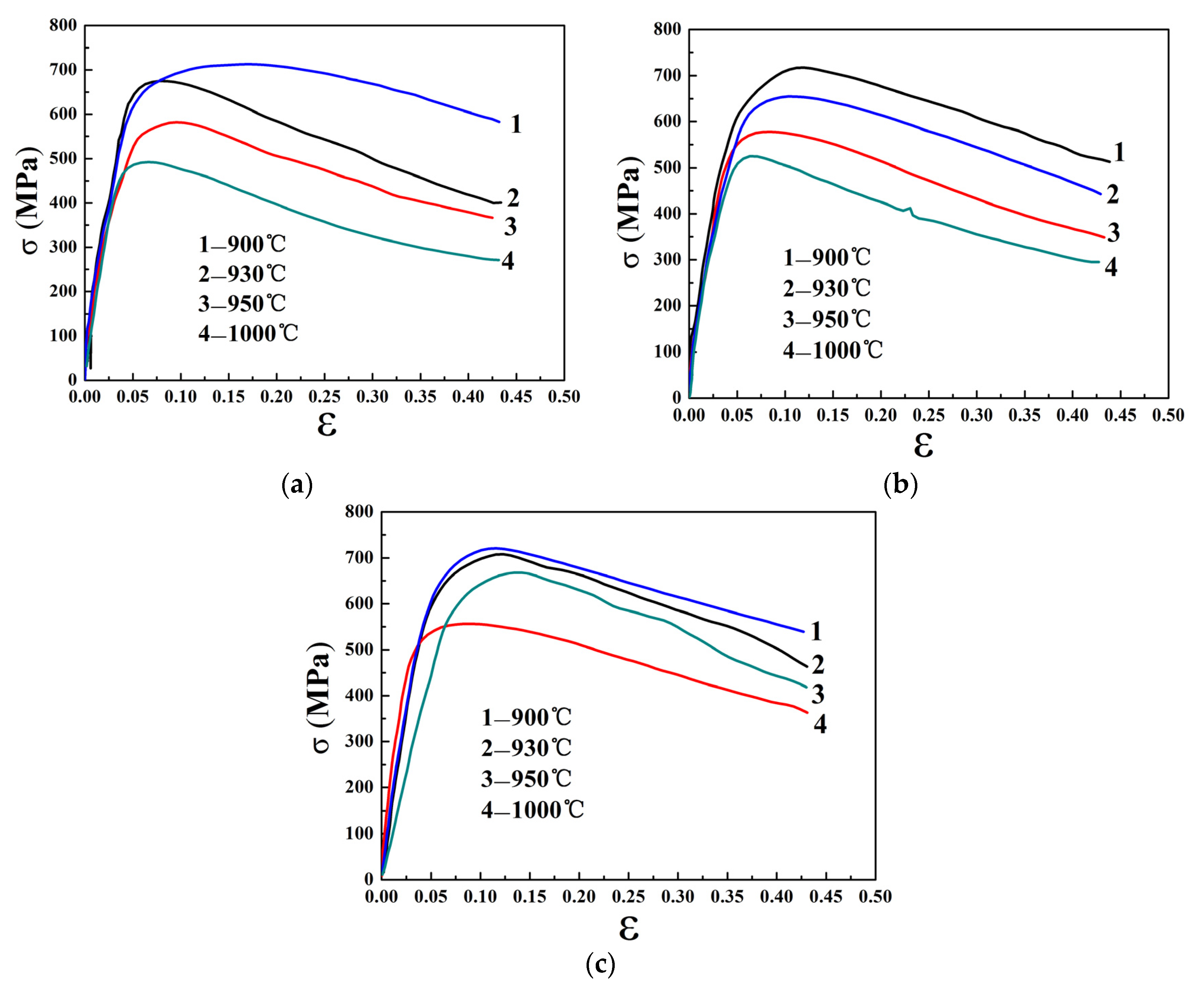
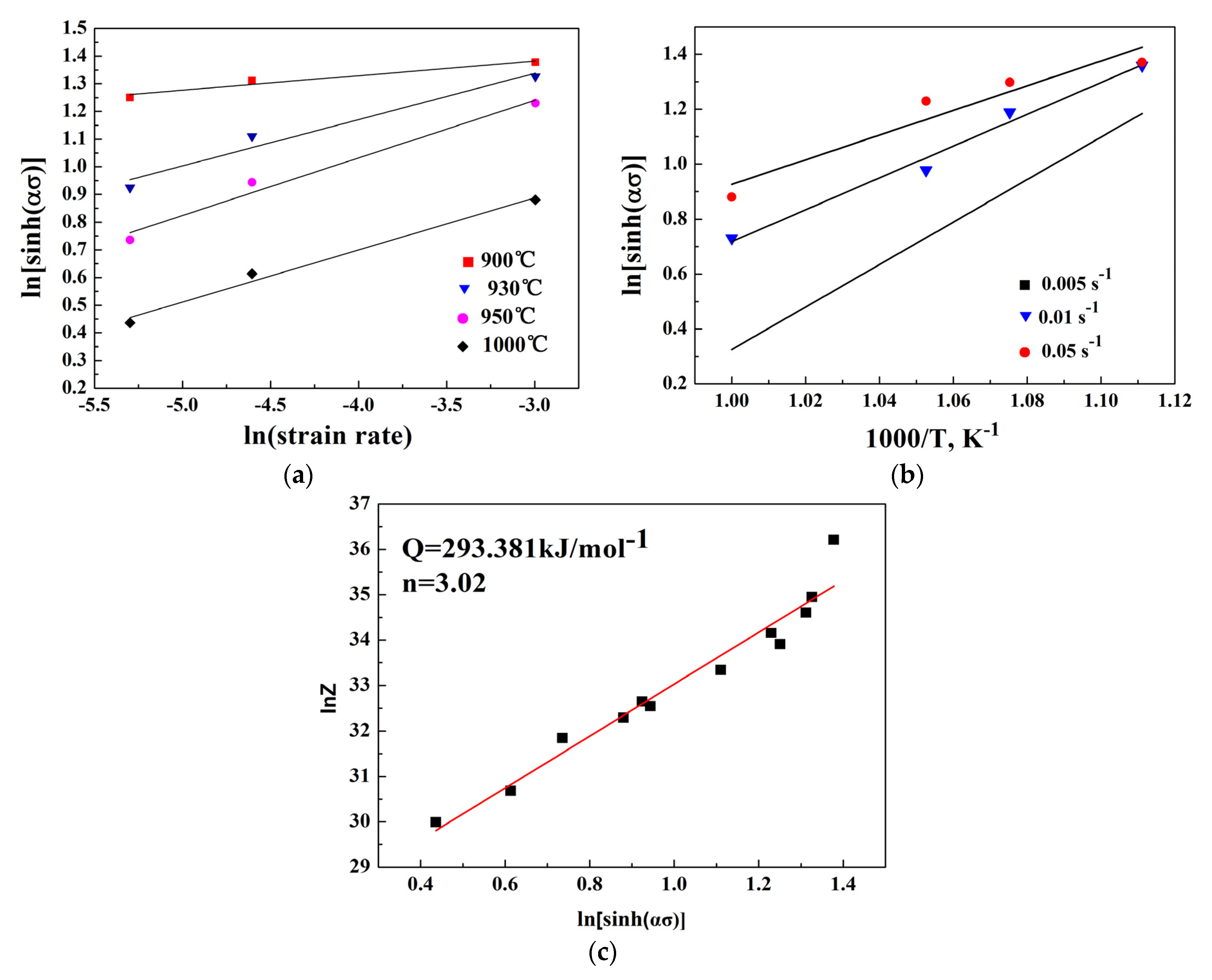
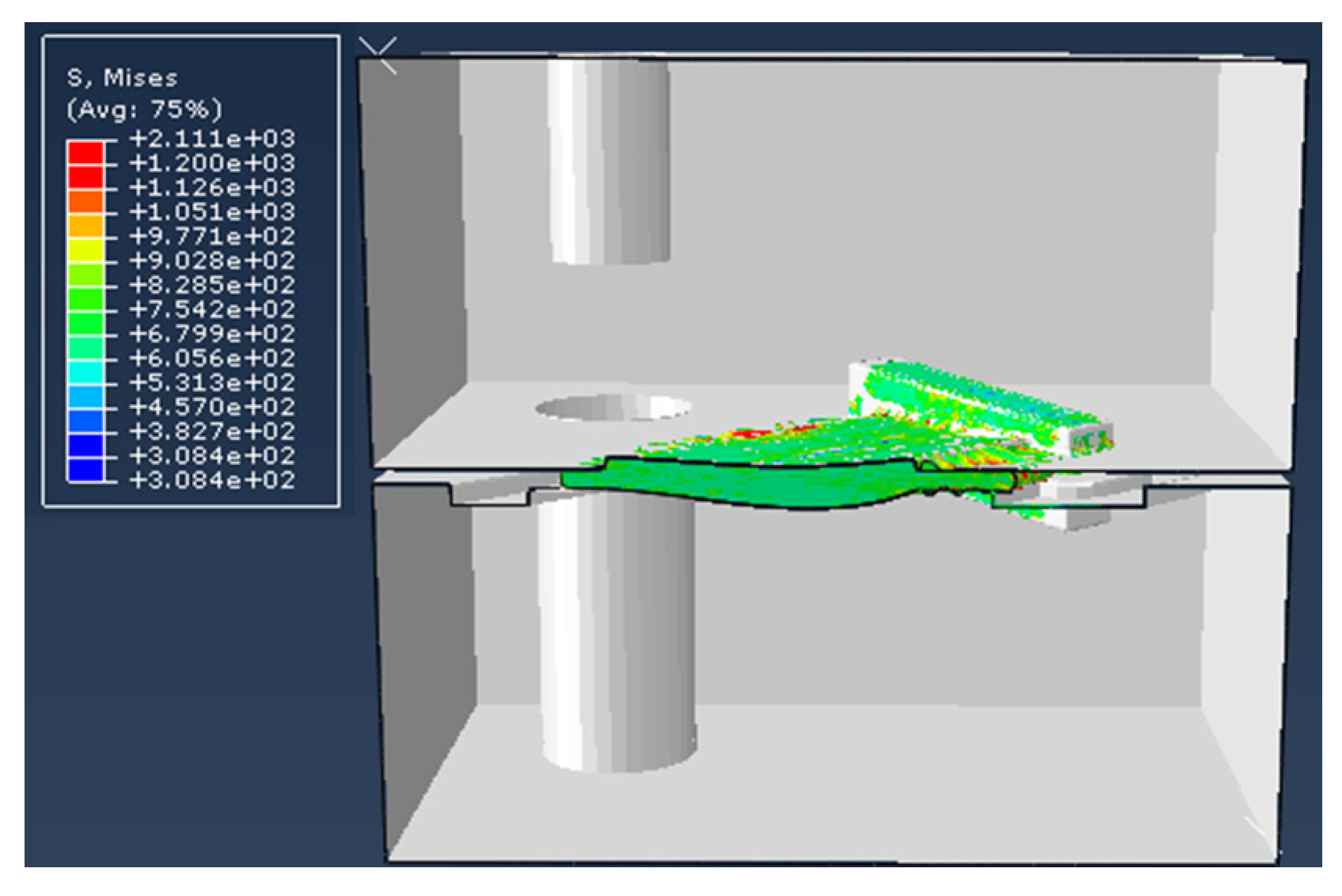


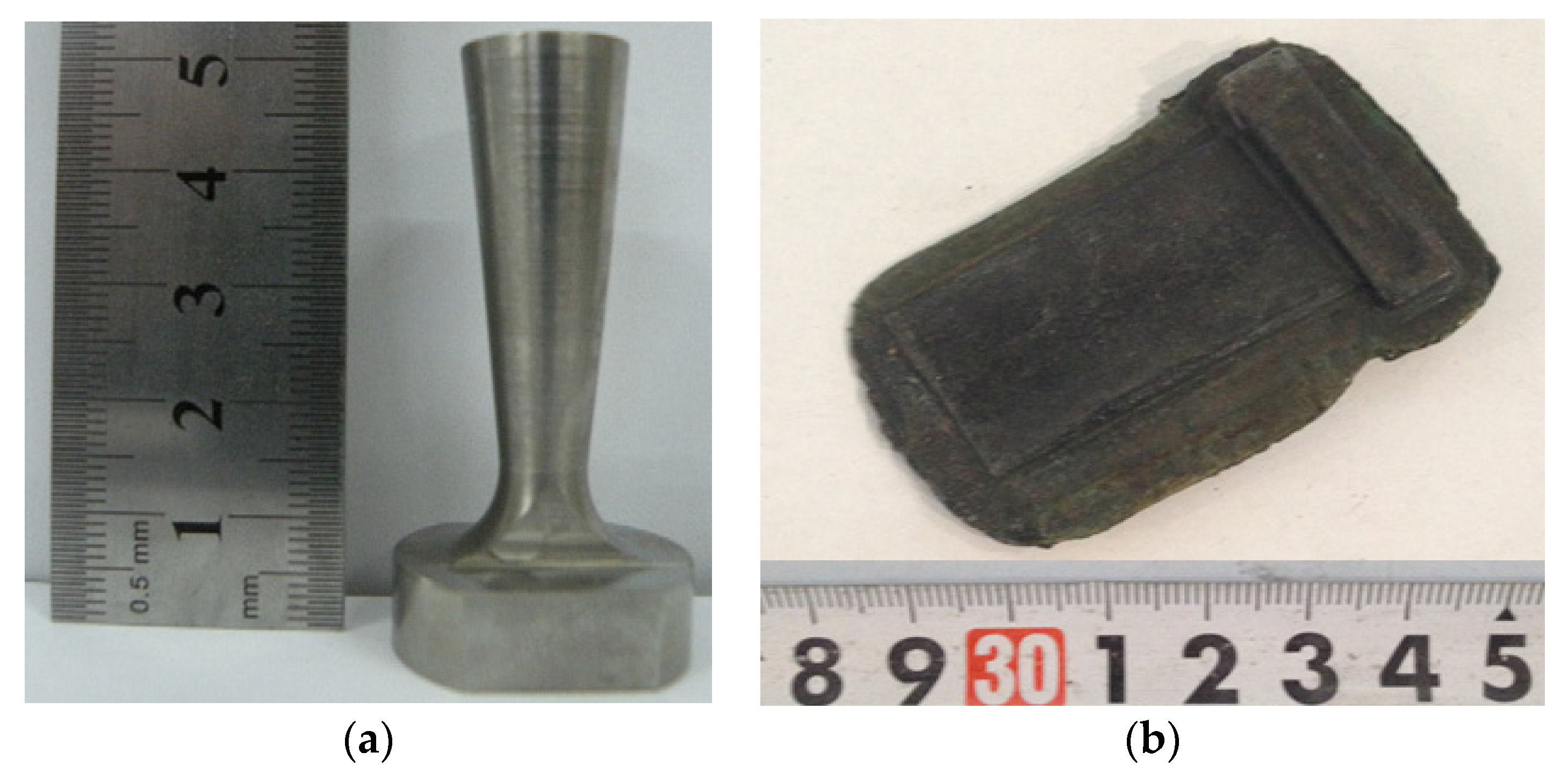
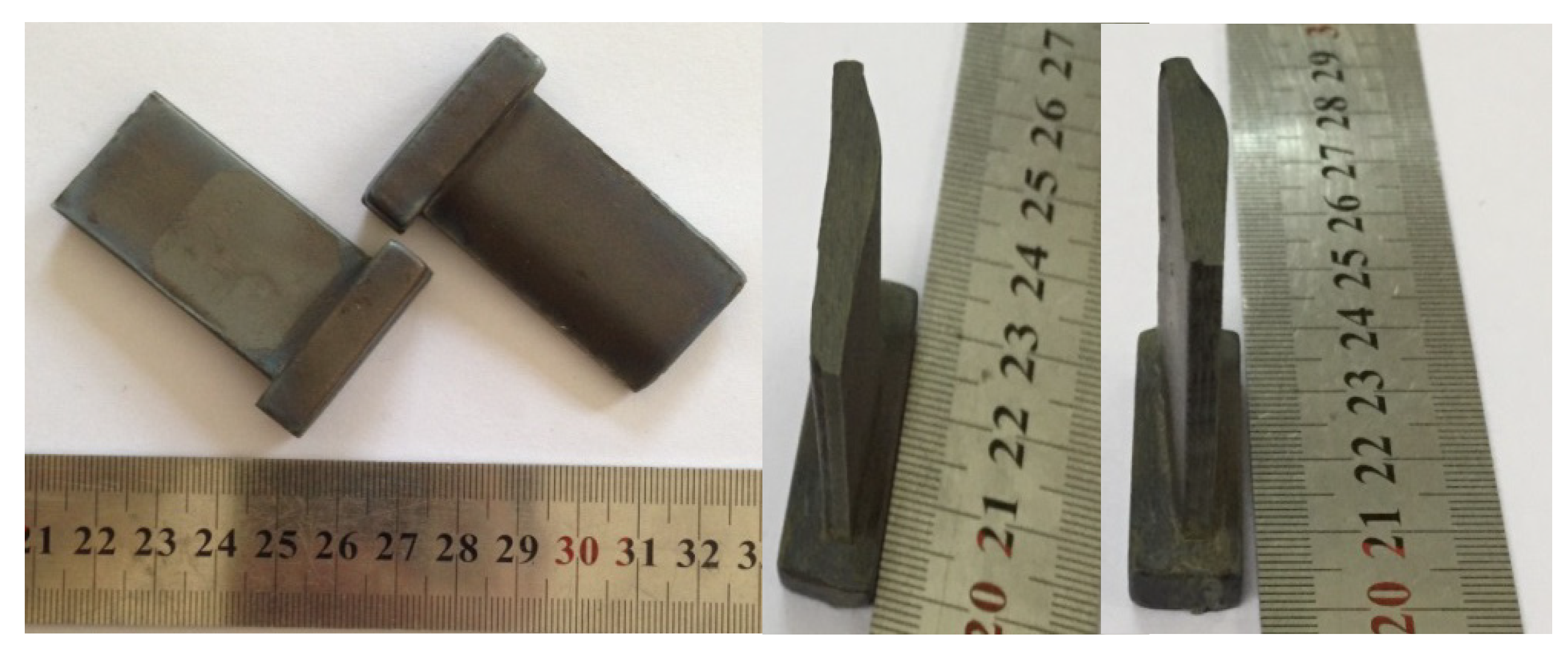
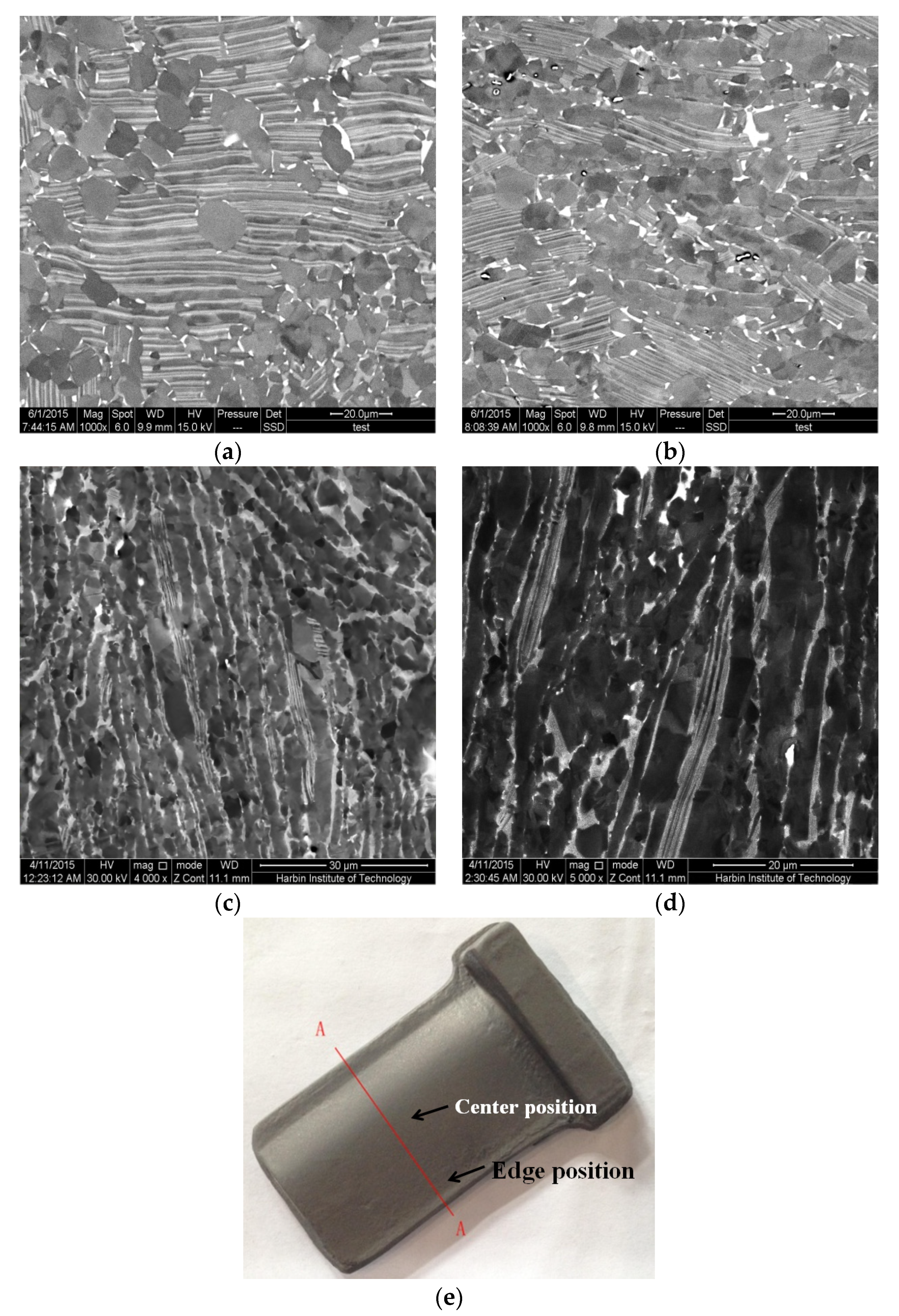
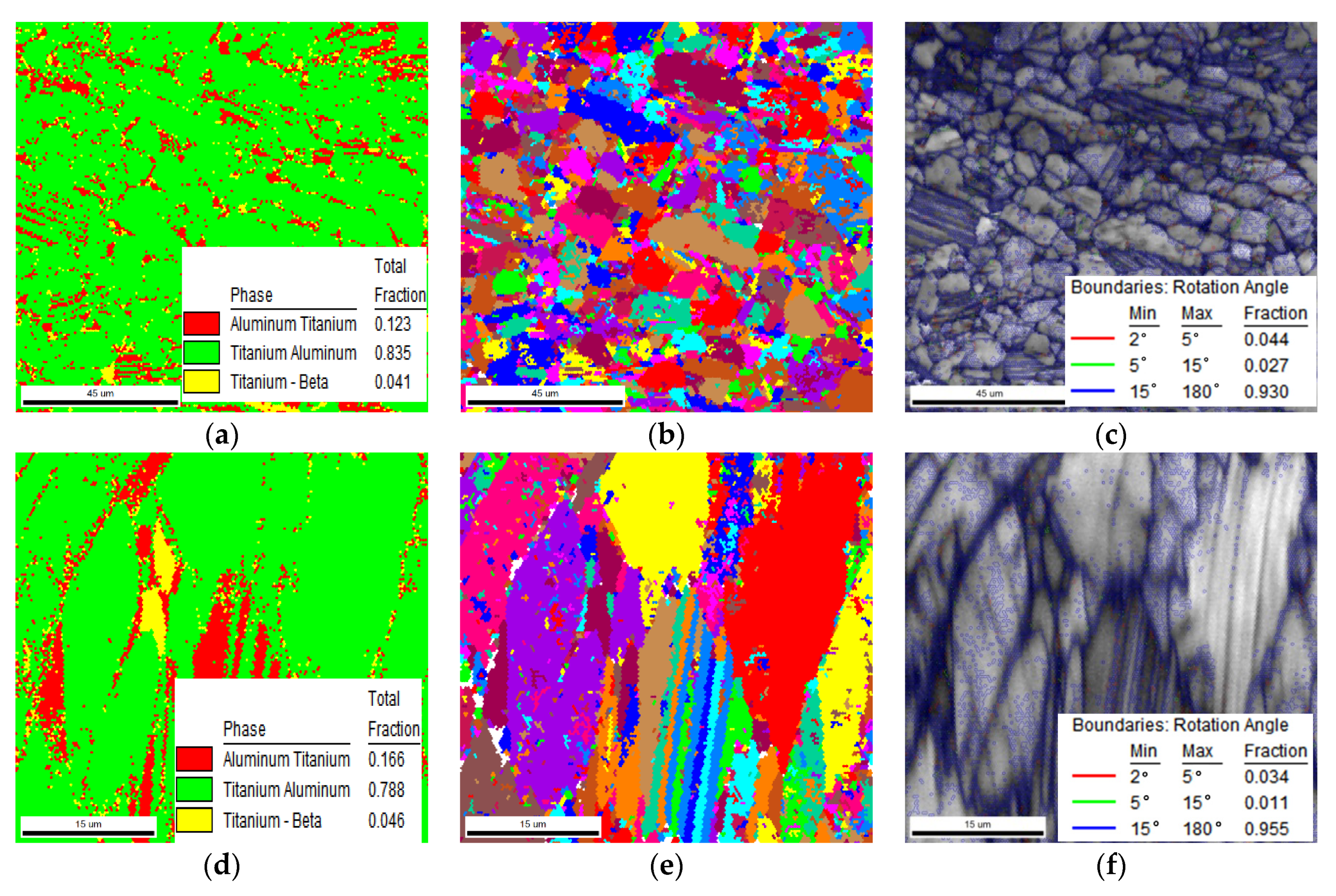

| Strain Rate | 0.005 s−1 | 0.01 s−1 | 0.05 s−1 | |
|---|---|---|---|---|
| Temperature | ||||
| 900 °C | 40% | 40% | 40% | |
| 930 °C | 50% | 40% | 40% | |
| 950 °C | 40% | 40% | 40% | |
| 1000 °C | 40% | 40% | 40% | |
| Temperature (°C) | Thermal Diffusivity (10−6 m2·s−1) | Heat Capacity (J·K−1·g−1) | Thermal Conductivity (W·K−1·m−1) | Coefficient of Thermal Expansion (mm·mm−1·C) |
|---|---|---|---|---|
| 25 | 4.10 | 588 | 11.1 | 2.05 × 105 |
| 500 | 6.90 | 638 | 20.0 | 2.11 × 105 |
| 700 | 7.33 | 658 | 21.7 | 2.14 × 105 |
| 800 | 7.88 | 668 | 23.1 | 2.19 × 105 |
| 900 | 7.60 | 678 | 23.1 | 2.22 × 105 |
| 1000 | 7.12 | 688 | 21.5 | 2.24 × 105 |
| 1100 | 6.79 | 698 | 19.8 | 2.30 × 105 |
© 2020 by the authors. Licensee MDPI, Basel, Switzerland. This article is an open access article distributed under the terms and conditions of the Creative Commons Attribution (CC BY) license (http://creativecommons.org/licenses/by/4.0/).
Share and Cite
Wang, X.; Xu, W.; Xu, P.; Zhou, H.; Kong, F.; Chen, Y. High Nb–TiAl Intermetallic Blades Fabricated by Isothermal Die Forging Process at Low Temperature. Metals 2020, 10, 757. https://doi.org/10.3390/met10060757
Wang X, Xu W, Xu P, Zhou H, Kong F, Chen Y. High Nb–TiAl Intermetallic Blades Fabricated by Isothermal Die Forging Process at Low Temperature. Metals. 2020; 10(6):757. https://doi.org/10.3390/met10060757
Chicago/Turabian StyleWang, Xiaopeng, Wenchen Xu, Peng Xu, Haitao Zhou, Fantao Kong, and Yuyong Chen. 2020. "High Nb–TiAl Intermetallic Blades Fabricated by Isothermal Die Forging Process at Low Temperature" Metals 10, no. 6: 757. https://doi.org/10.3390/met10060757
APA StyleWang, X., Xu, W., Xu, P., Zhou, H., Kong, F., & Chen, Y. (2020). High Nb–TiAl Intermetallic Blades Fabricated by Isothermal Die Forging Process at Low Temperature. Metals, 10(6), 757. https://doi.org/10.3390/met10060757








